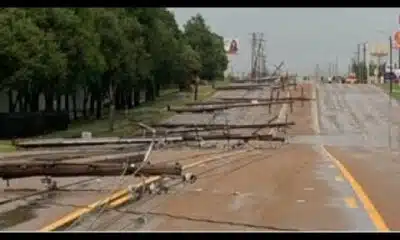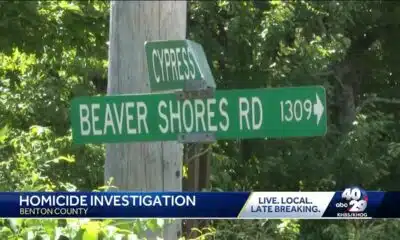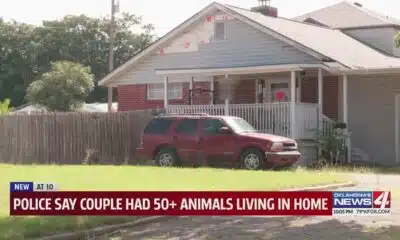News from the South - Texas News Feed
Do celebrity endorsements impact the election?
SUMMARY: Election Day has arrived, and experts are discussing potential voting trends. SMU political science professor Matthew Wilson explains the concepts of “red mirage” and “blue shift,” where early counts may misleadingly show Republican leads due to state ballot counting laws. With increased Republican participation in early voting, differences between pre-election and Election Day results may be less dramatic. Celebrity endorsements at rallies can attract crowds, but are not likely to be decisive. Texas’ Senate race is under national scrutiny, with expectations for potential party shifts in the Senate and House, as well as the likelihood of lawsuits impacting results.
From Beyonce to Elon Musk.. We have seen a lot of celebrities supporting both candidates – but does that really help a candidate?
News from the South - Texas News Feed
Scammers target volunteer fire department helping flood victims
SUMMARY: The Office of Attorney General Ken Paxton is investigating scammers who targeted the Center Point Volunteer Fire Department’s flood relief fundraiser after the devastating July 4 flood in Kerr County, which caused over 100 deaths. Scammers created fake Venmo accounts to divert donations, though Venmo shut them down quickly. Paxton vowed to use full authority against such fraud. The fire department’s genuine fundraiser continues via GoFundMe and mail donations. The Better Business Bureau warns of sophisticated AI-driven scams cloning websites and hijacking links. Donors are urged to verify payment sites, avoid wiring money, research charities, and be cautious of urgent appeals to prevent fraud.
The post Scammers target volunteer fire department helping flood victims appeared first on www.kxan.com
News from the South - Texas News Feed
Democratic doctor challenging GOP Rep. Monica De La Cruz
“Harlingen doctor becomes first Democrat to challenge GOP Rep. Monica De La Cruz for South Texas congressional seat” was first published by The Texas Tribune, a nonprofit, nonpartisan media organization that informs Texans — and engages with them — about public policy, politics, government and statewide issues.
Sign up for The Brief, The Texas Tribune’s daily newsletter that keeps readers up to speed on the most essential Texas news.
Ada Cuellar, a Harlingen-based emergency physician, launched her campaign for Texas’ 15th Congressional District on Thursday, becoming the first Democrat to run for the South Texas seat that her party is targeting in the 2026 midterms.
Anchored in Hidalgo County along the border and running north to the edge of San Antonio, the district — represented by Rep. Monica De La Cruz, R-Edinburg — has been emblematic of Democrats’ recent struggles throughout the Rio Grande Valley and with Latino voters generally. De La Cruz first won office in 2022, becoming the first Republican to represent the district after it was redrawn to favor Republicans.
The seat has been in Democrats’ crosshairs ever since. But South Texas was the epicenter of a national rightward shift in 2024 among Latinos, who make up about three-quarters of the 15th District’s eligible voting-age population, according to U.S. Census Bureau data. President Donald Trump was the first Republican to win Hidalgo County in decades, improving from a 28% vote share in 2016 to 51% last year.
Whoever wins the Democratic nomination will likely face an uphill battle. De La Cruz won reelection by 14 points in 2024, despite the Democratic Congressional Campaign Committee and other national groups targeting it as a potential pickup. The district leans Republican by a 7-point margin, according to the Cook Partisan Voting Index.
While Cuellar — who has no relation to Rep. Henry Cuellar, D-Laredo — is the first candidate to officially announce, Tejano music star Bobby Pulido has also been floated as a potential candidate. Pulido said he planned to enter politics in 2026, and he has been heavily recruited by Democrats, according to Politico.
Cuellar lives outside the district boundary, in the district of Rep. Vicente Gonzalez, D-McAllen. She is from Weslaco and went to college in Edinburg.
Members of Congress do not have to live in the district they represent, though residing outside the boundaries can open candidates to attacks from their opponents.
De La Cruz is the only Texas Republican the DCCC currently lists among its 2026 targets. But the spectre of redistricting, which could put more seats in play and upend the state’s political map, is hanging over both parties. South Texas is a key area where Republican map-drawers will likely try to draw friendlier seats by targeting De La Cruz’s Democratic neighbors, meaning the contours of the 15th District could change.
Under any new map, the district’s population is likely to remain overwhelmingly Hispanic — meaning Democrats will need to reverse their recent slide to have any chance of recapturing the seat.
Cuellar, a 43-year-old Rio Grande Valley native, believes Latino voters, in particular, were looking for change last cycle as they felt the bite of high costs fueled by inflation. She believes Democrats can position themselves as the party of change in 2026, especially on issues like health care, after Republicans including De La Cruz voted for Medicaid cuts as part of Trump’s recently enacted megabill.
“People are frustrated with health care costs, inflation, the economy, how difficult it is to succeed,” Cuellar said. “And I think a lot of frustrations were directed towards the Democratic Party.”
National Republicans expressed confidence they would hold onto the seat.
“Monica De La Cruz remains a steadfast advocate for the people of South Texas, consistently delivering commonsense results,” Zach Bannon, a spokesperson for the National Republican Congressional Committee, said in a statement. “Voters are eager to send her back to Washington to continue her work and will resoundingly reject any out of touch Democrat in the race.”
Democrats flipped the U.S. House in 2018 — including through pickups in Texas — largely by talking about Republicans’ efforts to quash the Affordable Care Act. Democrats hope to follow a similar playbook in 2026 by homing in on the Medicaid and ACA cuts in the megabill. Groups have been actively recruiting physicians like Cuellar to run for office as part of that pitch.
During her campaign, Cuellar said she also plans to discuss the need for a county hospital and more doctors in the district, along with plans to make health care more affordable.
Disclosure: Politico has been a financial supporter of The Texas Tribune, a nonprofit, nonpartisan news organization that is funded in part by donations from members, foundations and corporate sponsors. Financial supporters play no role in the Tribune’s journalism. Find a complete list of them here.
The lineup for The Texas Tribune Festival continues to grow! Be there when all-star leaders, innovators and newsmakers take the stage in downtown Austin, Nov. 13–15. The newest additions include comedian, actor and writer John Mulaney; Dallas mayor Eric Johnson; U.S. Sen. Amy Klobuchar, D-Minnesota; New York Media Editor-at-Large Kara Swisher; and U.S. Rep. Veronica Escobar, D-El Paso. Get your tickets today!
TribFest 2025 is presented by JPMorganChase.
This article originally appeared in The Texas Tribune at https://www.texastribune.org/2025/07/17/ada-cuellar-democrat-monica-de-la-cruz-south-texas-congress/.
The Texas Tribune is a member-supported, nonpartisan newsroom informing and engaging Texans on state politics and policy. Learn more at texastribune.org.
The post Democratic doctor challenging GOP Rep. Monica De La Cruz appeared first on feeds.texastribune.org
Note: The following A.I. based commentary is not part of the original article, reproduced above, but is offered in the hopes that it will promote greater media literacy and critical thinking, by making any potential bias more visible to the reader –Staff Editor.
Political Bias Rating: Center-Left
This article from The Texas Tribune leans Center-Left, primarily due to its emphasis on Democratic perspectives, framing of Republican actions, and favorable attention to Democratic candidate Ada Cuellar’s campaign. While the article includes factual data and references to Republican figures like Rep. Monica De La Cruz, the narrative highlights Democratic strategies, critiques of Republican policies (especially Medicaid cuts), and Cuellar’s policy priorities without equally presenting counterpoints from her Republican opponent. The language is measured and journalistic, but the thematic focus and selection of quotes subtly favor Democratic viewpoints.
News from the South - Texas News Feed
Court orders release of Uvalde school shooting records
“Appeals court orders release of Uvalde school shooting records” was first published by The Texas Tribune, a nonprofit, nonpartisan media organization that informs Texans — and engages with them — about public policy, politics, government and statewide issues.
Sign up for The Brief, The Texas Tribune’s daily newsletter that keeps readers up to speed on the most essential Texas news.
A state appeals court judge on Wednesday ordered Uvalde County and its school district to release records and documents related to the 2022 Robb Elementary School shooting, affirming a previous trial court order.
A coalition of 18 news organizations, including The Texas Tribune, sued the City of Uvalde, Uvalde County and the Uvalde Consolidated Independent School District in 2022 for access to body camera footage, 911 call records and communications made during the school shooting. Law enforcements’ response to Texas’ deadliest school shooting, in which 19 students and two teachers were killed, has been scrutinized extensively for failures in communication that delayed response time while the shooter was still in two classrooms with children.
Uvalde County District Attorney Christina Mitchell had opposed providing the records, pointing to criminal proceedings against former Uvalde school district Police Chief Pete Arredondo that she said could be hampered by the documents’ release. But Judge Velia Meza with Texas’ Fourth Court of Appeals wrote in the opinion for the case that the criminal proceedings and a separate lawsuit were not enough reasons to withhold the records.
“In response, these entities offered only minimal justification — citing a grand jury investigation and a civil lawsuit — without providing legal or evidentiary support for withholding the information,” Meza wrote.
Arredondo is facing several felony charges of child endangerment, with a trial date set for October.
In a statement, Laura Prather, a media law attorney with Haynes Boone representing the news organizations, said the ruling sends a clear message to government officials that “vague legal claims” cannot be used to withhold records.
“The public has waited more than three years for answers about what went wrong that day,” Prather said. “This decision brings us one step closer to those answers and preventing future tragedies.”
A spokesperson for the Uvalde school district said its school board and superintendent have scheduled a discussion about the requested records during their public meeting on July 21. The Uvalde County Sheriff’s Office did not respond to a request for comment. The order from Meza did not specify when the records would need to be released.
The lineup for The Texas Tribune Festival continues to grow! Be there when all-star leaders, innovators and newsmakers take the stage in downtown Austin, Nov. 13–15. The newest additions include comedian, actor and writer John Mulaney; Dallas mayor Eric Johnson; U.S. Sen. Amy Klobuchar, D-Minnesota; New York Media Editor-at-Large Kara Swisher; and U.S. Rep. Veronica Escobar, D-El Paso. Get your tickets today!
TribFest 2025 is presented by JPMorganChase.
This article originally appeared in The Texas Tribune at https://www.texastribune.org/2025/07/16/uvalde-school-shootings-records-release/.
The Texas Tribune is a member-supported, nonpartisan newsroom informing and engaging Texans on state politics and policy. Learn more at texastribune.org.
The post Court orders release of Uvalde school shooting records appeared first on feeds.texastribune.org
Note: The following A.I. based commentary is not part of the original article, reproduced above, but is offered in the hopes that it will promote greater media literacy and critical thinking, by making any potential bias more visible to the reader –Staff Editor.
Political Bias Rating: Centrist
This article primarily presents factual reporting on a legal decision involving the release of records related to the Uvalde school shooting. The tone is neutral and focused on public interest and transparency without showing ideological leanings or framing the story to favor a particular political viewpoint. It reports on actions taken by courts, law enforcement, and media organizations without editorializing or expressing bias. While the topic touches on sensitive issues like law enforcement accountability, the coverage remains straightforward and balanced, adhering to journalistic standards of impartiality.
-
News from the South - Tennessee News Feed5 days ago
Bread sold at Walmart, Kroger stores in TN, KY recalled over undeclared tree nut
-
News from the South - Georgia News Feed1 day ago
Aiken County family fleeing to Mexico due to Trump immigration policies
-
News from the South - Arkansas News Feed7 days ago
Man shot and killed in Benton County, near Rogers
-
News from the South - Alabama News Feed6 days ago
Girls Hold Lemonade Stand for St. Jude Hospital | July 12, 2025 | News 19 at 10 p.m. – Weekend
-
News from the South - Georgia News Feed7 days ago
Anti-ICE demonstrators march to Beaufort County Sheriff's Office
-
News from the South - Oklahoma News Feed7 days ago
Police say couple had 50+ animals living in home
-
Mississippi Today4 days ago
Coast judge upholds secrecy in politically charged case. Media appeals ruling.
-
Mississippi Today1 day ago
Driver’s license office moves to downtown Jackson









































